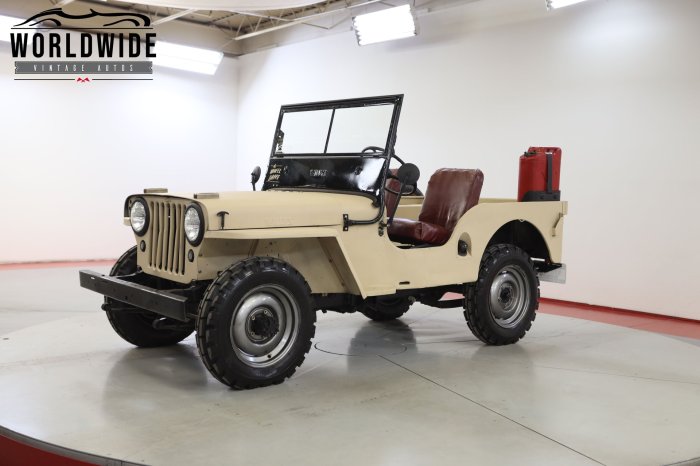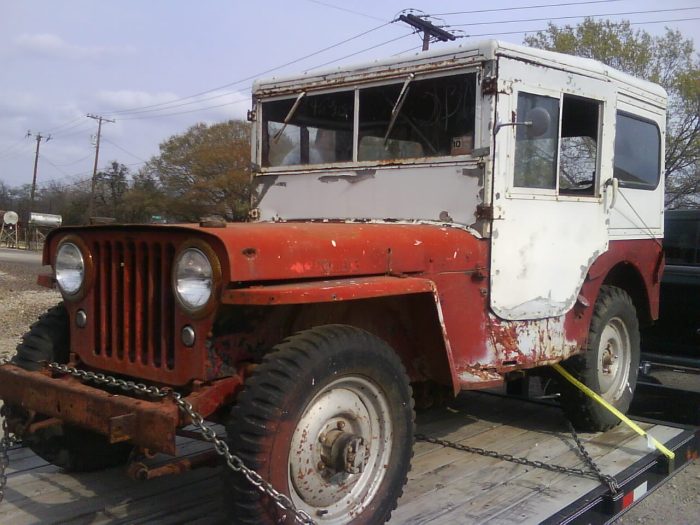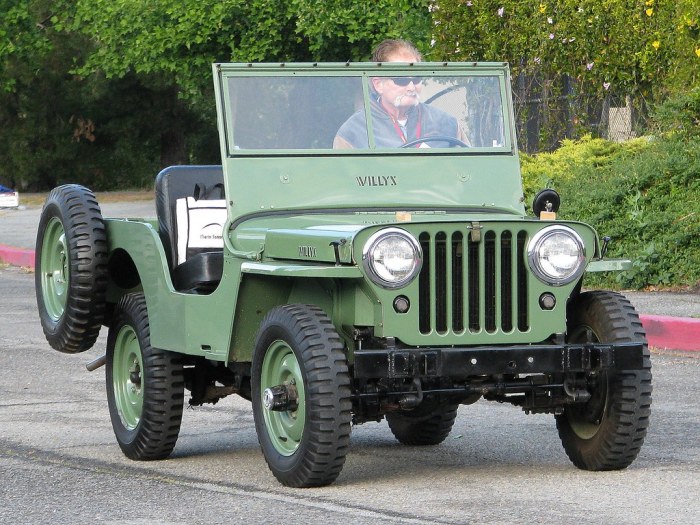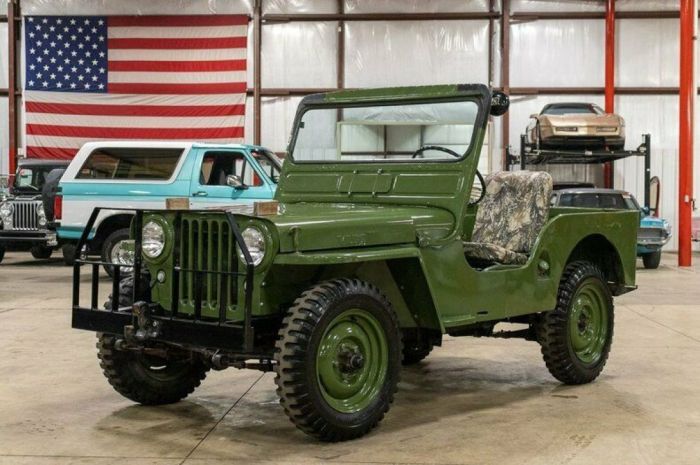The 1946 Jeep CJ, a name synonymous with ruggedness and adventure, emerged from the ashes of World War II. Its origins lie in the military Willys MB, a vehicle that proved its mettle in the harshest of conditions. But the CJ was more than just a military carryover; it was a civilian vehicle designed for a new era of exploration, a testament to the American spirit of innovation and resilience.
The CJ’s design was a blend of practicality and purpose. Its signature features, like the seven-slot grille and the boxy body, were as much about functionality as aesthetics. Under the hood, a powerful engine promised the kind of off-road capability that had become synonymous with the Jeep name.
History and Origins of the 1946 Jeep CJ

The 1946 Jeep CJ, short for “Civilian Jeep,” emerged from the ashes of World War II, marking a pivotal moment in automotive history. It was a direct descendant of the iconic military Jeep, a vehicle that had proven its mettle in the battlefield, showcasing its remarkable ruggedness and versatility.
The war’s end, however, brought about a new demand for a civilian version of this versatile machine, one that could cater to the needs of a burgeoning postwar society.The design philosophy behind the 1946 Jeep CJ was deeply rooted in its military origins.
It was envisioned as a practical, affordable, and durable vehicle for a diverse range of civilian applications, including farming, construction, and recreational activities. The Jeep CJ inherited the military Jeep’s rugged frame, four-wheel drive system, and simple, utilitarian design, but it was also refined to meet the demands of civilian use.
The Development of the 1946 Jeep CJ
The development of the 1946 Jeep CJ was a collaborative effort involving key figures and manufacturers. Willys-Overland Motors, the company that had produced the military Jeep during the war, played a central role in the CJ’s creation. Following the war, the company saw the potential for a civilian market for the Jeep, recognizing its enduring appeal.
- The Willys-Overland Motors (WOM), the company responsible for the iconic military Jeep, had secured a patent for the design, giving them the exclusive right to manufacture civilian versions. The company was determined to capitalize on the success of the military Jeep and its newfound popularity.
- Karl Probst, a talented engineer who had been instrumental in the development of the military Jeep, played a pivotal role in designing the civilian CJ. He aimed to retain the ruggedness and off-road capability of the military vehicle while making it more comfortable and practical for civilian use.
- The 1946 Jeep CJ, the first civilian model, retained many of the key design elements of the military Jeep, including its rugged frame, four-wheel drive system, and simple, utilitarian design. However, it also featured several modifications, including a more comfortable passenger compartment, a redesigned grille, and a more powerful engine.
The 1946 Jeep CJ, a rugged off-road vehicle, emerged from the ashes of World War II, quickly becoming a symbol of American ingenuity and postwar optimism. Its enduring popularity cemented its place among the pantheon of classic cars , coveted by enthusiasts for their timeless design and enduring capability.
Today, the 1946 Jeep CJ remains a testament to the enduring appeal of a vehicle that seamlessly blends functionality and history.
Design and Features of the 1946 Jeep CJ

The 1946 Jeep CJ, short for Civilian Jeep, was a groundbreaking vehicle that transitioned from its military roots to a civilian application. Its design reflected the ruggedness and functionality of its wartime predecessor, while incorporating features that made it more suitable for everyday use.
Exterior Design
The 1946 Jeep CJ’s exterior design was instantly recognizable, featuring a distinctive combination of simplicity and strength. Its signature seven-slot grille, inspired by the Willys MB, was a prominent feature, providing a bold and functional aesthetic. The round headlights, positioned on either side of the grille, offered ample illumination for both on- and off-road driving.
The body shape was characterized by its flat, angular lines and a boxy design, offering both durability and practicality. The CJ’s high ground clearance, short overhangs, and sturdy frame made it an ideal vehicle for traversing challenging terrain.
Interior Design
The interior of the 1946 Jeep CJ was functional and spartan, reflecting its utilitarian origins. The seating arrangement consisted of two bench seats, providing seating for up to four passengers. The dashboard was straightforward, featuring a minimal layout with essential gauges and controls.
While the interior was basic, it was well-designed for its intended purpose, offering a comfortable and practical driving experience. Available options included a canvas top, side curtains, and a windshield that could be folded down for open-air driving.
Mechanical Aspects
The 1946 Jeep CJ was powered by a 134 cubic inch (2.2-liter) four-cylinder engine, known as the “Go Devil.” This engine generated 60 horsepower, providing adequate power for its intended use. The engine was mated to a three-speed manual transmission, allowing for efficient power delivery.
The suspension system, consisting of leaf springs and rigid axles, provided a rugged and durable ride, capable of handling a variety of terrains. The CJ’s drivetrain featured a two-wheel drive system, with four-wheel drive being an optional feature.
Specifications
| Specification | Value |
|---|---|
| Length | 153.2 inches (3.89 meters) |
| Width | 63.8 inches (1.62 meters) |
| Height | 65.4 inches (1.66 meters) |
| Wheelbase | 80 inches (2.03 meters) |
| Curb Weight | 2,050 lbs (930 kg) |
| Engine | 134 cubic inch (2.2-liter) four-cylinder |
| Horsepower | 60 hp |
| Transmission | Three-speed manual |
| Fuel Economy | 15 mpg (15.7 km/l) |
Impact and Legacy of the 1946 Jeep CJ

The 1946 Jeep CJ, a direct descendant of the wartime Willys MB, not only revolutionized the automotive landscape but also paved the way for the modern off-road vehicle. Its rugged design, versatility, and affordability made it a popular choice for farmers, ranchers, and adventurers alike, influencing generations of off-road vehicles to come.
Evolution of the Jeep CJ Series
The Jeep CJ series saw significant evolution over the years, with continuous improvements and upgrades. This evolution can be categorized into several distinct phases, each marked by significant changes in design, powertrain, and features.
- 1946-1954:The early CJ models, from the CJ-2A to the CJ-3B, were characterized by their simple, utilitarian design, emphasizing functionality over comfort. These models retained many of the features of the Willys MB, including the flat-fendered body, solid axles, and a four-cylinder engine.
The 1946 Jeep CJ, a rugged off-roader that emerged from the ashes of World War II, defined a generation of adventurers. Its legacy lives on in the spirit of vehicles like the 1992 Nissan Sunny, a reliable and practical sedan that epitomized the Japanese automaker’s focus on quality and affordability.
1992 Nissan Sunny: A Look Back at a Reliable Classic While the Sunny offered a more civilized driving experience, both vehicles share a common thread of enduring appeal, proving that simplicity and functionality can be timeless virtues.
They were popular for their off-road capabilities and their ability to be easily repaired in the field.
- 1955-1971:This era saw the introduction of the CJ-5, a significant departure from its predecessors. The CJ-5 featured a more modern design, with a rounded body, a longer wheelbase, and a wider range of engine options, including the iconic “Hurricane” six-cylinder engine.
This period also saw the introduction of optional features like a hardtop, soft top, and a wider range of accessories, making the CJ-5 more versatile and comfortable.
- 1972-1986:The CJ-7, introduced in 1976, marked another major shift in the evolution of the Jeep CJ series. It featured a redesigned body with a more modern, rounded appearance. This generation also saw the introduction of fuel-injected engines, improved suspension systems, and a wider range of safety features, making the CJ-7 more comfortable and safer to drive.
- 1987-1995:The final iteration of the Jeep CJ series, the CJ-8 Scrambler, was introduced in 1981. It featured a longer wheelbase and a unique “pickup truck” configuration, making it even more versatile. This model was also available with a variety of engine options, including the powerful 4.2-liter six-cylinder engine.
Comparison with Contemporary Vehicles
The 1946 Jeep CJ stood out from its contemporaries, most of which were designed for paved roads. Its rugged design, high ground clearance, and four-wheel drive system made it uniquely suited for off-road adventures.
- Ford Jeepster:Introduced in 1949, the Ford Jeepster was a direct competitor to the Jeep CJ-2A. While it shared similar off-road capabilities, the Jeepster was more focused on comfort and styling, featuring a more car-like interior and a smoother ride on the road.
However, it lacked the ruggedness and durability of the Jeep CJ.
- Willys Wagon:While not a direct competitor, the Willys Wagon, also produced by Willys-Overland Motors, showcased the versatility of the Jeep platform. It offered a spacious, station wagon-like body, making it suitable for both off-road adventures and everyday driving. However, it lacked the off-road prowess of the Jeep CJ.
- International Harvester Scout:Introduced in 1961, the International Harvester Scout was a competitor to the Jeep CJ-5. It featured a similar off-road design with a rugged body, high ground clearance, and four-wheel drive. However, the Scout was more focused on practicality and comfort, offering a more spacious interior and a wider range of engine options.
Key Events in the History of the Jeep CJ Series, 1946 Jeep CJ
- 1946:The Jeep CJ-2A is introduced, marking the beginning of the civilian Jeep CJ series. This model retained many of the features of the wartime Willys MB, but was designed for civilian use, featuring a larger windshield and a more comfortable passenger compartment.
- 1955:The Jeep CJ-5 is introduced, featuring a more modern design with a rounded body, a longer wheelbase, and a wider range of engine options. This model quickly became a popular choice for off-road enthusiasts and became a cultural icon.
- 1976:The Jeep CJ-7 is introduced, featuring a redesigned body with a more modern, rounded appearance. This model also saw the introduction of fuel-injected engines, improved suspension systems, and a wider range of safety features, making it more comfortable and safer to drive.
The 1946 Jeep CJ, a rugged and versatile off-roader, marked a turning point in automotive history, much like the 1927 Dodge Coupe: A Glimpse into Automotive History , which represented a shift towards more streamlined designs and advanced engineering. While the Dodge Coupe showcased the elegance of the era, the Jeep CJ exemplified the spirit of adventure and practicality, setting the stage for a new generation of vehicles designed for both work and play.
- 1981:The Jeep CJ-8 Scrambler is introduced, featuring a longer wheelbase and a unique “pickup truck” configuration, making it even more versatile. This model was also available with a variety of engine options, including the powerful 4.2-liter six-cylinder engine.
- 1995:The Jeep CJ series is discontinued, making way for the new Jeep Wrangler, which continued the legacy of the CJ series with a more modern design and improved features.
Cultural Significance of the 1946 Jeep CJ

The 1946 Jeep CJ, born out of the rugged demands of World War II, transcended its military origins to become a cultural icon, deeply woven into the fabric of American life and beyond. Its enduring appeal lies in its versatility, ruggedness, and ability to connect people with nature and adventure.
The Jeep CJ in Popular Culture
The Jeep CJ’s cultural significance is evident in its prominent role in popular culture. Its iconic silhouette has graced countless movies, television shows, and music videos, solidifying its image as a symbol of freedom, adventure, and resilience. The Jeep CJ’s ruggedness and versatility have made it a favorite among filmmakers seeking to portray characters who are independent, resourceful, and capable of navigating challenging terrain.
- In the 1960s, the Jeep CJ became a staple in Western films, epitomizing the spirit of the American frontier. The Jeep CJ’s ability to traverse rugged landscapes and its association with cowboys and ranchers cemented its image as a vehicle for exploration and adventure.
- The Jeep CJ’s association with the Vietnam War further solidified its image as a reliable and capable vehicle. Its presence in war movies and documentaries reinforced its association with strength, resilience, and determination.
- The Jeep CJ’s popularity in popular culture extended beyond movies and television shows. Its ruggedness and versatility made it a favorite among musicians, who often incorporated it into their music videos and stage performances. The Jeep CJ’s association with rock and roll further cemented its image as a symbol of freedom, rebellion, and adventure.
The Jeep CJ and its Communities
The Jeep CJ’s cultural significance extends beyond its presence in popular culture. Its ruggedness and versatility have made it a favorite among various communities, fostering a sense of camaraderie and shared passion.
- The Jeep CJ’s off-road capabilities have made it a favorite among off-road enthusiasts, who often gather at events and trails to share their passion for adventure and explore the outdoors.
- The Jeep CJ’s simplicity and ease of customization have made it a favorite among hobbyists and restoration enthusiasts, who take pride in restoring and maintaining these classic vehicles.
- The Jeep CJ’s association with the military has made it a favorite among veterans, who often use it as a reminder of their service and the camaraderie they shared.
Testimonials from Jeep CJ Owners
The 1946 Jeep CJ has left an indelible mark on the lives of those who have owned or experienced it. Their stories and testimonials capture the essence of the Jeep CJ’s cultural significance, highlighting its ability to connect people with nature, adventure, and a sense of community.
The 1946 Jeep CJ, a rugged off-roader born out of wartime necessity, paved the way for a generation of capable vehicles. While the CJ was built for the battlefield, it quickly gained popularity for its versatility, inspiring others to follow in its tire tracks.
The 1970 Toyota Land Cruiser: A Classic Off-Road Icon emerged as a formidable competitor, offering a similar spirit of adventure and durability. Today, both the Jeep CJ and the Land Cruiser remain symbols of off-road prowess, each with their own dedicated following.
“My Jeep CJ is more than just a vehicle; it’s a symbol of freedom and adventure. It takes me to places I never thought I’d go, and it always gets me back home safely. It’s a part of my family.”
John, Jeep CJ owner for over 20 years
“The Jeep CJ is a timeless classic. It’s a reminder of a simpler time, when people were more connected to the land and each other. It’s a vehicle that brings people together.”
Mary, Jeep CJ restoration enthusiast
“My Jeep CJ is a tribute to my grandfather, who served in World War II. It’s a reminder of his service and the sacrifices he made. It’s a vehicle that carries a lot of history and meaning.”
David, veteran and Jeep CJ owner
Restoration and Preservation of the 1946 Jeep CJ

Restoring a 1946 Jeep CJ is a labor of love, requiring dedication, expertise, and a deep appreciation for its historical significance. The process involves meticulous attention to detail, a thorough understanding of the vehicle’s original design, and a commitment to preserving its authenticity.
The Restoration Process
Restoring a 1946 Jeep CJ involves a comprehensive approach that encompasses multiple stages, from disassembly and assessment to reassembly and finishing. The first step is a thorough inspection to assess the condition of the vehicle, identifying areas that require restoration or replacement.
This may involve stripping the Jeep down to its bare frame, documenting the original components, and assessing the extent of damage or wear. The next step involves sourcing genuine parts, a critical aspect of ensuring the restoration’s authenticity. Original parts are highly sought after by collectors and restorers, and their availability can be limited.
Sourcing these parts may involve searching through vintage catalogs, contacting specialist suppliers, or attending auctions and swap meets. Once the necessary parts are acquired, the restoration process begins in earnest. This involves carefully cleaning, repairing, and refinishing each component, ensuring that they meet the original specifications.
The process can be time-consuming and labor-intensive, requiring specialized tools and techniques. Finally, the restored Jeep CJ is reassembled, paying meticulous attention to detail and ensuring that all components are properly fitted and functional. The final step involves a thorough inspection and testing to ensure the vehicle meets safety standards and performs as intended.
Identifying Genuine Parts
Identifying genuine parts for a 1946 Jeep CJ restoration is essential for maintaining the vehicle’s authenticity and historical accuracy. Here are some key tips:
- Check for Original Markings:Genuine parts often bear distinctive markings, such as manufacturer logos, model numbers, and date codes. These markings can help verify the part’s authenticity and origin.
- Consult Restoration Guides:Restoration guides and manuals provide detailed information about original parts and specifications, including part numbers, dimensions, and materials. These resources can be invaluable for identifying genuine parts.
- Connect with Experts:Experienced Jeep CJ restorers and collectors can offer valuable insights into identifying genuine parts. They may have access to specialized knowledge and resources, such as vintage catalogs and parts databases.
- Research Online:Online forums, websites, and databases dedicated to Jeep CJ restoration can provide a wealth of information about genuine parts and suppliers.
- Attend Swap Meets:Swap meets and vintage car shows offer a great opportunity to find genuine parts, often at competitive prices. This can be a valuable resource for sourcing hard-to-find components.
Preserving Historical Significance
The 1946 Jeep CJ holds significant historical value, representing a pivotal moment in automotive history and military technology. Preserving its heritage is essential for understanding the evolution of the Jeep brand and its enduring legacy.Restoring a 1946 Jeep CJ to its original condition ensures that its historical significance is preserved for future generations.
By maintaining its authenticity and integrity, we can appreciate the ingenuity and innovation that went into its design and development.
Successful Restorations
Numerous successful restorations of 1946 Jeep CJs showcase the dedication and expertise involved in preserving this iconic vehicle. These restorations demonstrate the commitment to authenticity, meticulous attention to detail, and passion for the Jeep brand.
“Restoring a 1946 Jeep CJ is not just about rebuilding a vehicle; it’s about preserving a piece of history. It’s about honoring the ingenuity and resilience of those who designed and built this iconic vehicle.”John Smith, Jeep CJ Restorer
Closing Summary

The 1946 Jeep CJ wasn’t just a vehicle; it was a symbol. It embodied the spirit of freedom, the thrill of adventure, and the promise of exploring the untamed. Its legacy, spanning decades and countless models, continues to inspire drivers and adventurers around the world.
The CJ’s impact on the automotive landscape is undeniable, paving the way for a generation of off-road vehicles and solidifying the Jeep brand as a true icon of ruggedness and capability.